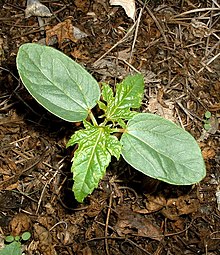Dicotyledonous
The division of living beings into systematics is a continuous subject of research. Different systematic classifications exist side by side and one after the other. The taxon treated here has become obsolete due to new research or is not part of the group systematics presented in the German-language Wikipedia.


The dicotyledons or dicotyledons (Dicotyledoneae, Magnoliatae) were one of two traditional classes of flowering plants (Magnoliophyta) and were distinguished from the other class, the monocotyledons , according to the number of their cotyledons . In contrast to the monocotyledons, the dicotyledons are not a natural related group, which is why they have been separated into the two groups single-furrow pollen dicotyledons (Magnoliopsida) and three-furrow pollen dicotyledons or eudicotyls (Rosopsida).
features
The characteristic that gives it its name is the twofold number of cotyledons, which applies to all representatives with a few exceptions (e.g. some lark spurs with only one cotyledon or degeneria with three to four). The vascular bundles in the shoot axes are designed as Eustele , that is, arranged in a circle. Secondary growth in thickness using the cambium is common.
The roots are mostly long-lived ( allorhizia ) and have an oligarchic vascular bundle. The leaves are varied, mostly they have a distinct petiole and a reticulate vein. They often have stipules , rarely leaf sheaths .
The flowers are usually arranged in five- (four-) whorls, the flower envelope is often differentiated into calyx and crown. Two- or three-digit whorls are rare, as is a helical position. The pollen tetrads are usually formed simultaneously, the pollen grains usually have three furrows (tricolpat). The endosperm is nuclear or cellular, but never typically helobial.
The original and widespread form of life is the tree . Herbaceous forms are considered to be derived.
Chemical characteristics include: frequent occurrence of ellagic acid and ellagitannins , of condensed and hydrolyzable tannins , of essential oils , of triterpenic acids , of polyterpenes (such as rubber ), of alkaloids , triterpene saponins , of calcium oxalate in the form of drusen, and of slime with uronic acid component .
Botanical history
In 1682, John Ray was the first to recognize that not all seed plants have two cotyledons. In 1703 he divided the Bedecktsamer into the two groups Dicotyledones and Monocotyledones. Antoine Laurent de Jussieu took over the structure in 1778 and also used it in his work Genera Plantarum in 1789 . This dichotomy remained until the 1990s when it was recognized that the dicotyledons do not form a natural family group (are not monophyletic ). The basal groups of the flowering plants were separated from the actual "eudicotyledons" and are referred to as single-furrow pollen dicotyledons. The eudicotyledons are monophyletic, while the furrow pollen dicotyledons are still paraphyletic .
Sources and further information
- P. Sitte , H. Ziegler, F. Ehrendorfer, A. Bresinsky : Textbook of botany for universities . G. Fischer Verlag, Stuttgart, Jena, New York, 1991, p. 761f. ISBN 3-437-20447-5
Individual evidence
- ↑ Lidén M. (1993) Fumariaceae. In: Kubitzki K., Rohwer JG, Bittrich V. (eds) Flowering Plants · Dicotyledons. The Families and Genera of Vascular Plants, vol 2. Springer, Berlin, Heidelberg
- ↑ Degeneriaceae on the AP website (accessed on January 5, 2008)
- ↑ Dietrich Frohne, Uwe Jensen: Systematics of the plant kingdom with special consideration of chemical characteristics and plant drugs . 4th revised edition. Gustav Fischer, Stuttgart / Jena / New York 1992, ISBN 3-437-20486-6 , pp. 100 .
- ^ Gerhard Wagenitz : Dictionary of Botany. The terms in their historical context. 2nd, expanded edition. Spektrum Akademischer Verlag, Heidelberg / Berlin 2003, ISBN 3-8274-1398-2 , pp. 83f.